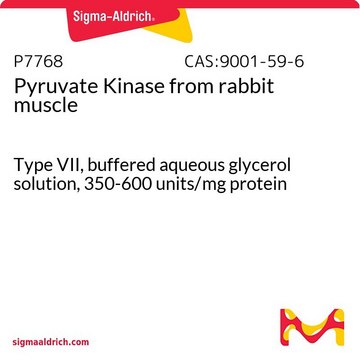推薦產品
應用
Suitable for:
- Sequencing or nucleic acid tagging (DNA and RNA) by 5′-end labeling
- 5′ phosphorylation of oligonucleotides
- Removal of 3′-phosphate groups from phosphorylpolynucleotides
成分
T4 Polynucleotide Kinase is supplied in a solution of 50% glycerol (v/v), 20 mM Tris-HCl (pH 7.5), 25 mM KCl, 2mM DTT, 0.1 mM EDTA, and 0.1 μM ATP.
原則
Polynucleotide kinase catalyses a "forward reaction" transfer of the γ-phosphate of ATP to the 5′ hydroxyl terminus of single- and double-stranded nucleic acids (DNA and RNA) and 3′-nucleoside monophosphates. In exchange reactions containing ADP, the enzyme will catalyze the exchange of 5′-terminal phosphate groups and ATP. The 3′-phosphatase activity enables the enzyme to remove 3′-phosphoryl groups from phosphorylpolynucleotides.
1. Forward reaction: Transfer of the labeled γ-phosphate from [γ-32P]-ATP to the free 5′-hydroxyl group of the substrate.
5′-HO-DNA + [γ-32P]-ATP → 5′-32PO-DNA + ADP.
Substrates that do not have a free 5′-hydroxyl require prior dephosphorylation by alkaline phosphatase.
2. Exchange reaction: First, the terminal 5′-phosphate is transferred from the substrate to ADP present in the reaction mixture. Then, the labeled γ-phosphate from [γ-32P]-ATP is transferred to the free hydroxyl group of the substrate.
5′-PO-DNA + ADP → 5′-HO-DNA + ATP
5′-HO-DNA + [γ-32P]-ATP → 5′-32PO-DNA + ADP
1. Forward reaction: Transfer of the labeled γ-phosphate from [γ-32P]-ATP to the free 5′-hydroxyl group of the substrate.
5′-HO-DNA + [γ-32P]-ATP → 5′-32PO-DNA + ADP.
Substrates that do not have a free 5′-hydroxyl require prior dephosphorylation by alkaline phosphatase.
2. Exchange reaction: First, the terminal 5′-phosphate is transferred from the substrate to ADP present in the reaction mixture. Then, the labeled γ-phosphate from [γ-32P]-ATP is transferred to the free hydroxyl group of the substrate.
5′-PO-DNA + ADP → 5′-HO-DNA + ATP
5′-HO-DNA + [γ-32P]-ATP → 5′-32PO-DNA + ADP
單位定義
One unit catalyzes the transfer of one nanomole of 32P to the 5′-end of micrococcal nuclease-treated DNA in 30 min. at 37 °C. Transfer is detected as incorporation into acid-insoluble material.
分析報告
Activity is determined in a reaction mixture containing 40 mM Tris-HCl (pH 7.5), with 10 mM MgCl2, 5 mM dithiothreitol, 0.5 mM 5′-OH polynucleotide ends, and mM [γ-32P]-ATP.
相關產品
產品號碼
描述
訂價
訊號詞
Danger
危險聲明
危險分類
Resp. Sens. 1
儲存類別代碼
10 - Combustible liquids
水污染物質分類(WGK)
WGK 3
閃點(°F)
Not applicable
閃點(°C)
Not applicable
個人防護裝備
Eyeshields, Gloves, multi-purpose combination respirator cartridge (US)
分析證明 (COA)
輸入產品批次/批號來搜索 分析證明 (COA)。在產品’s標籤上找到批次和批號,寫有 ‘Lot’或‘Batch’.。
Priscilla Braglia et al.
EMBO reports, 11(10), 758-764 (2010-09-04)
Transcription termination by RNA polymerase I in Saccharomyces cerevisiae is mediated by a 'torpedo' mechanism: co-transcriptional RNA cleavage by Rnt1 at the ribosomal DNA 3'-region generates a 5'-end that is recognized by the 5'-3' exonuclease Rat1; this degrades the downstream
V Cameron et al.
Biochemistry, 16(23), 5120-5126 (1977-11-15)
The purification of T4 polynucleotide kinase results in the copurification of an activity which will specifically remove the 3'-terminal phosphate from a variety of deoxyribonucleotides and ribonucleotides in the absence of ATP. This phosphatase activity requires magnesium, has a pH
Saranya Siribal et al.
Molecular and biochemical parasitology, 180(1), 1-7 (2011-08-09)
Polynucleotide kinase/phosphatase (PNKP) is a bifunctional enzyme that can phosphorylate the 5'-OH termini and dephosphorylate the 3'-phosphate termini of DNA. It is a DNA repair enzyme involved in the processing of strand break termini, which permits subsequent repair proteins to
Takao Mori et al.
Molecular biology of the cell, 21(21), 3722-3734 (2010-09-17)
The unfolded protein response (UPR) is an essential signal transduction to cope with protein-folding stress in the endoplasmic reticulum. In the yeast UPR, the unconventional splicing of HAC1 mRNA is a key step. Translation of HAC1 pre-mRNA (HAC1(u) mRNA) is
Wenhe Wu et al.
Chemical communications (Cambridge, England), 47(4), 1201-1203 (2010-11-26)
We designed a single-fluorophore-tagged hairpin-structured nano-beacon probe by using a superquencher, graphene oxide (GO), based on which a new method for the analysis of DNA phosphorylation detection was developed.
我們的科學家團隊在所有研究領域都有豐富的經驗,包括生命科學、材料科學、化學合成、色譜、分析等.
聯絡技術服務







